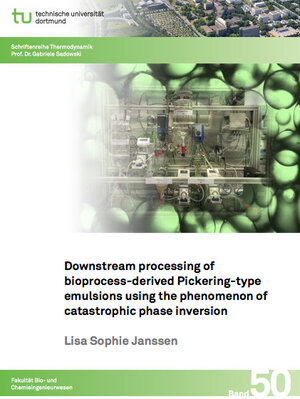
×
![Buchcover ISBN 9783843954143]()
Downstream processing of bioprocess-derived Pickering-type emulsions using the phenomenon of catastrophic phase inversion
von Lisa Sophie JanssenBiphasic whole-cell biocatalytic processes have already demonstrated a high potential for bio-based synthesis. Although high stereoselectivity and product concentrations are achievable using an additional organic phase as substrate reservoir and product sink, industrial implementation of these promising processes is limited due to the formation of long-term stable Pickering-type emulsions, caused by the presence of particles / cells. State-of-the-art-concepts for the aqueous/organic phase separation fail or include inefficient and costly strategies (excessive centrifugation / the use of de-emulsifiers). It was recently shown, that using the phenomenon of catastrophic phase inversion (CPI), efficient phase separation can be achieved by addition of dispersed phase. To show the industrial applicability of CPI as an innovative tool for the phase separation of long-term stable bioprocess-derived Pickering-type emulsions, the mutual influence of the emulsion components and thus emulsion phase behavior and stability has to be known. Several Pickering-type emulsions from biphasic (aqueous/organic) cultivation of Escherichia coli JM101 and Pseudomonas putida KT2440 cells were characterized to identify key parameters for the apparent emulsion behavior / stability. Based on the parameters of cell radius, the wettability of cells and the interfacial tension, we suggest guidelines and estimation strategies for suitable process (window) selection and choice of optimal organic phase (with respect to separate ability). Enabling a continuous separation process, also termed applied catastrophic phase inversion (ACPI), a fully automated lab-scale prototype was designed and constructed within this work, followed by several test runs using the previously characterized bioprocess-derived Pickering-type emulsions. These investigations revealed ideal process settings for a stable (continuous) phase separation process.


